Erica Jurus's Blog
October 14, 2025
75 years of “funny pictures”
“Charles M. Schulz was an innovative genius, creating a fantasy world that connected to kids as well as adults and all based on powerful iconic characters who express deep feelings of loneliness and resentment and despair. The feeling that everything is against us. The craving for love. An enormous earnestness for doing the right thing. There is not much in Peanuts that is shallow or heedless.”
Garrison Keillor
Charles Schulz was nicknamed Sparky by an uncle when he was only two days old, after a horse named Spark Plug in the wildly popular Barney Google comic strip. It was a name he chose to keep using, and became prophetic when he began submitting his own comics professionally.
As a child, he read the comics every Sunday morning with his father – Mickey Mouse, Popeye, Skippy – and from early on knew that he wanted to be a cartoonist. When he reached his teens, his drawing of his family dog, Spike was published in the nationally-syndicated Ripley’s Believe it or Not newspaper, and as a senior in high school he enhanced his skills through a correspondence cartoon course with the Federal School of Applied Cartooning.
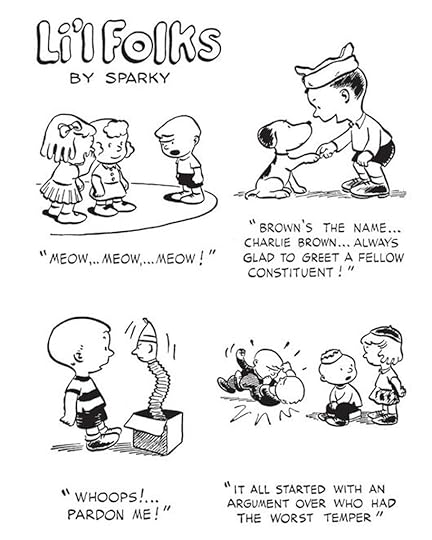 First appearance of a “Charlie Brown” from a May 30, 1948 strip of Li’l Folks; By Charles Schulz – Peanuts wikia, Public Domain, https://commons.wikimedia.org/w/index.php?curid=165487808
First appearance of a “Charlie Brown” from a May 30, 1948 strip of Li’l Folks; By Charles Schulz – Peanuts wikia, Public Domain, https://commons.wikimedia.org/w/index.php?curid=165487808“Peanuts was originally sold under the title of Li’l Folks, but that had been used before, so they said we have to think of another title. I couldn’t think of one and somebody at United Features came up with the miserable title Peanuts, which I hate and have always hated. It has no dignity and it’s not descriptive. […] What could I do? Here I was, an unknown kid from St. Paul. I couldn’t think of anything else. I said, why don’t we call it Charlie Brown and the president said “Well, we can’t copyright a name like that.” I didn’t ask them about Nancy or Steve Canyon. I was in no position to argue.” Charles Schulz, in a 1987 interview with Frank Pauer in Dayton Daily News and Journal Herald Magazine
Throughout his life, Schulz remained intensely irritated by the title foisted on his creation. Whenever he was asked what he did for a living, he’d only say that “I draw that comic strip with Snoopy in it, Charlie Brown and his dog”. He looked into changing the title to Charlie Brown many times but eventually understood that it would cause a domino effect of problems with all of the licensees.
Of course, all of his devoted fans have known and loved the strip and the books as Peanuts ever since. However, the animated specials invariably used the name of one of the characters, usually the hapless hero of Schulz’s world, Charlie Brown.
The first strip, in 1950, was four panels long and showed Charlie Brown walking by two other kids, Shermy and Patty. Snoopy appeared in the third strip, but most of the other characters that eventually became regulars were introduced later: supercilious Violet and the piano-playing Schroeder in 1951, irritable Lucy and charmingly laid-back Linus in 1952, the dust-shrouded Pig-Pen in 1954, and so on. My favourite character, Snoopy’s little sidekick bird named Woodstock, showed up in 1966.
All of the Peanuts world was seen through the eyes of the children and the critters. They weren’t idealized. Lucy was often mean to Charlie Brown, and he spent most of his time trying to gain the respect of those around him, with little success. Schulz said that Charlie Brown had to be “the one who suffers, because he is a caricature of the average person. Most of us are much more acquainted with losing than we are with winning.” But, as in real life, Charlie had his happy moments as well.
The formula appealed with its gentle, amusing look at the trials and tribulations of children unfettered by adult issues. Schulz said that grown-ups just didn’t interest him, and indeed, any adults that appeared were only expressed through unarticulated sounds.
By the 1960s, Peanuts comic strip was reaching 355 million readers around the world. In 1965, the Coca-Cola Company approached Lee Mendelson, the producer, about sponsoring a Peanuts Christmas television special showing “the true meaning of Christmas”. Mendelson called Schulz, and the rest is animation history.
A Charlie Brown Christmas was first broadcast by CBS on December 9, 1965. Despite its unorthodox, jazzy soundtrack, and its overtly religious message, which worried some of the execs, it was a massive success – an estimated 15,490,000 homes watched the special, and it ended up receiving both an Emmy and Peabody Award. It’s become an iconic Christmas special for the past sixty years, and the soundtrack is instantly recognizable.
That success led to the creation of a second CBS television special, Charlie Brown’s All-Stars in 1966, followed by probably the second-most popular special, the Halloween-themed It’s the Great Pumpkin, Charlie Brown.
In those days, Halloween and Christmas were both eagerly anticipated holidays in a child’s world, so a Halloween special was a natural.
I’m not sure modern viewers understand what time capsules both the Christmas and Halloween specials are. In the 1960s, it was safe for children to walk around after dark by themselves. My aunt, even though she was fairly traditional-European, had a silver Christmas tree, which she decorated with glossy blue balls and which I thought was quite beautiful.
Halloween was equally important, as our chance to run around in costume, on our own, gathering as much candy as we could fit in pillowcases, which held quite a haul. The streets were dark, lit only by a few streetlights and the jack o-lanterns on porches. Sometimes we couldn’t tell if a house was handing out candy, so we’d approach carefully and knock with trepidation, ready to run if an ogreish owner appeared. When we got home, my brother and I would dump out all of our treasures onto the living room carpet and sort through them, trading any we didn’t like.
The party games that the kids play in the Halloween special were classic, although most of the parties I went to also included a séance, usually to summon Harry Houdini (it never worked, although an errant bit of wind blowing through a pop bottle once scared the crap out of us).
But the specials perfectly captured the vibe of the times, much simpler despite Charlie Brown’s feelings about holiday commercialization, and with an innocence that’s been lost. I don’t know about you, but I watch them every year, and lately have been enjoying the clips posted by the Schulz Museum online. I love Snoopy’s attempts to write a book, and his “It was a dark and stormy night” has become immortal in writing circles.
By the time Charles Schulz passed away in 2000, Peanuts had run in more than 2,600 newspapers, had a readership of around 355 million in 75 countries, and had been translated into 21 languages. Together with its merchandise, the strip and its offshoots earned Schulz more than $1 billion. Not bad for someone who just wanted to “draw funny pictures”.
“I suppose there are some people out there who will think I’m a foolish old romantic, possibly even a little nuts, to have such an association with, even to the point of talking to, an inanimate object [like Snoopy]. Peanuts fans know better. [They] know that the greatest of Charles Schulz’s magic tricks was bringing life to all those wonderful folks with which he peopled our world and brightened our days.”
Walter Cronkite
October 7, 2025
The Spectre of Book Banning
I remember watching reruns of The Dick Van Dyke Show on television when I was younger and thinking how silly it was to show Rob and Laura Petrie sleeping in twin beds. Clearly they’d had sex in order to have their son Ritchie, but the show was produced while the Hays Code was still in effect, which meant pretending that somehow the boy had been magically conceived without getting down and dirty.
The Hays Code, named after Will H. Hays, who was the president of the Motion Picture Producers and Distributors of America from 1922 to 1945, was a knee-jerk reaction to several notorious scandals in Hollywood in the 1920s. The biggest of these was the alleged rape of starlet Virginia Rappe by the enormously popular movie star Roscoe “Fatty” Arbuckle at a party he hosted.
Virginia had become ill at the party and died four days later. One of her friends accused Arbuckle of raping and accidentally killing her. After three trials, Arbuckle was acquitted and the third jury even gave Arbuckle a written apology. Despite that, Arbuckle’s films were banned by Hays, who’d become the motion picture industry’s censor, and the actor became a symbol of what various groups perceived as the growing debauchery in Hollywood and its effect on the ‘morals of the general public’. The scandal destroyed Arbuckle’s career.
Under Hays’s leadership, Hollywood was compelled to adopt the Production Code in 1930, and it was rigidly enforced from 1934 to 1968, even covering television production.
So, back to the on-screen illusion that couples, married or otherwise, didn’t actually sleep together and that kids were produced by some kind of spontaneous genesis. Apparently, by denying in the media that sex existed, people would then not engage in any. A strange concept of cause and effect.
The same principle today is being brought forth in book banning form – that what we can’t read about will just cease to exist.
This is Banned Books Week in the U.S., similar to our Canadian Freedom to Read Week in February, and there’s a lot of media coverage globally. I’m far from an expert on the subject, but here are my thoughts.
What is a book ban, exactly? Although technically it’s the removal of a book from a library’s collection, up to and including actual destruction, many people also point out that there may be books which are purposely never ordered.
Logistically, libraries simply can’t house every single book ever written. But the idea that small groups can force a library to remove a book over the wishes of thousands of other people is disturbing.
Here’s how a book ban comes about:
A specific title is challenged on the basis of its content. It doesn’t just have to be at a library – challenges take place within entire school districts, at institutions, retailers, publishers, etc.The book in question is pulled from access for a review period, which could take months.Sometimes the book is banned, other times put back into the collection.Why are books challenged? According to the American Library Association, by 2020 the top ten reasons were:
sexual content (92.5% percent of books on the list)offensive language (61.5%)unsuited to age group (49%)religious viewpoint (26%)LGBTQIA+ content (23.5%)violence (19%)racism (16.5%)use of illegal substances (12.5%)“anti-family” content (7%)political viewpoint (6.5%)As you can see, there’s a lot of attempted censorship around things that we know actually take place, but are seemingly afraid to acknowledge.
I haven’t read most of the books in the top banning lists to be able to comment on their contents (books like To Kill a Mockingbird and The Handmaid’s Tale). But surely ignoring parts of our collective history or potential future is unhealthy, and ultimately dangerous.
I don’t have children, but I understand that parents want to keep an eye on what their children are consuming. I list my own novels as suitable for 18+ based on some violence/horror and sexual content. However, when parents ask me at live events, I always recommend that they make their own decision based on what they know of their own kids.
My novels also include ‘diversity, equity and inclusion’. What’s wrong with that? Isn’t that the way life should be?
What does it matter that someone has a different religious viewpoint than us? Or a different sexual orientation?
I can’t even begin to understand how it must be to feel that you’re in the wrong body gender, but plenty of people don’t know what it’s like to have fibromyalgia, as I do, so who are we to invalidate another’s experience? And aren’t books that illuminate our differences to others beneficial, to spread understanding?
There’s a place in this world for all of us. But there’s no place for oppression or intolerance, both of which keep rearing their ugly heads no matter how much we think we’ve progressed. Can we ever get past them?
Banning books is a way of exterminating ideas.
To learn more about book banning in Canada, I recommend this article in The Walrus.
September 30, 2025
Ghost Hunting – Do you believe?
“At first cock-crow the ghosts must go
Back to their quiet graves below” Theodosia Garrison
Ghost-hunting, aka paranormal investigation, is big business these days. There have been a variety of these engagements filmed for television – I’ll even admit to watching a handful myself.
I’m not sure what it is that I find so fascinating. The sense of mystery, the hope that there’s a larger world than the prosaic one we live in day to day. The potential confirmation of an afterlife, for anyone who’s lost a loved one.
Whatever it is, I find myself with the lights off and glued to my flat-screen, waiting to see what makes an appearance.
The first recorded claim of a sighting of the ghost was by Lucia C. Stone took place at a Christmas party at Raynham Hall in Norfolk, England in 1835. Among the invited guests was a Colonel Loftus, who said he and another guest had seen a ghost they called the “Brown Lady”, in a vintage brown brocade dress, glowing but with empty sockets, as they were walking down the hall to their bedrooms. This prompted a number of staff decamping the estate permanently.
In 1936, a Captain Hubert C. Provand and Indre Shira, two photographers who were assigned to photograph Raynham Hall for Country Life magazine, took a photo of the Brown Lady, which was published in Country Life magazine. The figure in the image is thought to be the ghost of Lady Dorothy Townshend, wife of Charles Townshend, 2nd Viscount of Raynham in the early 1700s. Charles suspected his wife of infidelity, and, although she apparently died in 1726, some suspected that the funeral had been faked and that Charles had actually locked his wife away in a remote corner of the house for the remainder of her life.
As ghosts are said to occur when there’s been a wrongful death in some way, if I were Lady Dorothy I would certainly have haunted the ass off Lord Charles. Whatever the truth may be, it makes a good story. The photo is a remarkable image, and has gained considerable credence.
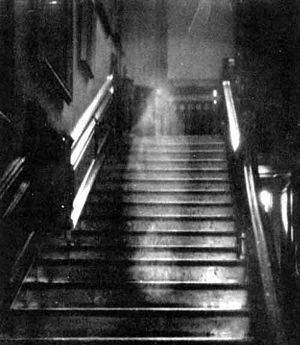 Claimed photograph of the ghost, taken by Captain Hubert C. Provand. First published in
Country Life
, 1936
Claimed photograph of the ghost, taken by Captain Hubert C. Provand. First published in
Country Life
, 1936By Historical image, Brown Lady Ghost photo. Originally taken in 1936 by Captain Hubert C. Provand (Indre Shire Inc.), and published in the magazine ‘Countrylife’ in the same year. This version downloaded from about.com, 2/22/2010. No information available about original image size, though this version is unlikely to be a high-quality reproduction. The image has been replicated freely in numerous locations (on the internet, in paper media, and on recorded media such as tv shows), but its copyright status (despite being over 70 years old) cannot currently be determined., Fair use, https://en.wikipedia.org/w/index.php?curid=26302476
I can’t say I’ve ever been interested in doing the hunting myself, although we did actually participate in a kind of ghost hunt in the town of Gettysburg, PA, site of the biggest bloodbath of the American Civil War. It’s reputed to be one of the most haunted places in the US, given how many people died in terrible agony. We accompanied a couple of ladies out to several locations, where we were given various instruments that would indicate the presence of ghosts. On a bridge called The Hanging Bridge (the name speaks for itself), I sat on the wooden bridge slats next to one of the hosts, as she called up a program on her laptop that would serve as a voice ‘bridge’ with the afterlife. The laptop quickly began chattering away, as if there was a grand party amongst the departed all around us. However, the needle on the meter in my hand didn’t budge even a smidge. I restrained myself from saying, “Shouldn’t this thing be doing something?”
At the next location, where a reputed witch had been lynched, nothing ethereal happened, but several of us spotted tiny pricks of light from bioluminescent fungi on the forest floor, so that was pretty cool.
By the time I began getting nighttime chills in the third location, where everyone else was convinced they were discerning messages from the laptop software and oohing enthusiastically, my hubby and I decided we’d had enough for the evening.
In no way am I saying that I don’t believe in ghosts, just that often when we expect or really desire something to happen, it will, at least in our own perception.
Several years ago, I read a good article on what good ghost-hunting involves, and traps to look out for. I no longer have the provenance of the article, but here are some insights from it:
Ghost manifestations have certain common elements: a) ghosts seem to have a limited lifespan and fade with time, although I’ve never seen anyone specify an expiry date; b) disturbances such as renovation or demolition will often piss of ghosts, who then become very active; c) ghosts are frequently reported in places where there’s water in the area, such as a stream or river – or, even more ominously, buried water.
Our minds can be easily fooled, or influenced, by the circumstances of an investigation, so ghost hunters should be trained to take into account certain variables, such as:
Sensory Deprivation: when the investigators are sitting in low light levels and no sound. Whatever ambient noises and bits of light occur, our brains will try to make sense of them, not always reliably.
A “Sense of Presence”: the feeling that there’s someone or something in the room that can’t be seen, is common. An investigator’s expectations of coming across a ghost, together with awareness of the haunted reputation of the building, causes a heightened state of suggestibility. Experiments have shown that things I the environment, like exposure to extremely low frequency sound waves from electrical equipment, or wind blowing through a window, cause shivering, breathlessness, anxiety and a feeling of an unseen presence.
Pareidolia: I’ve read a lot about this phenomenon, and we’ve probably all experienced it – when our brain sees human faces and shapes in random things like clouds, or the grain on a piece of wood, or even potatoes a pieces of toast.
The eye fools us: two visual phenomena – ideoretinal light, where flashes of light or colour appear in the field of vision in the absence of sensory stimulation, as in a darkened room, and entoptic phenomena, also known as “floaters” (debris within the fluid in our eyes).
Auditory Illusions: because ourspeech consists of a variety of sounds, frequencies and rhythms, it’s possible to misperceive sounds as a human voice, especially if the investigator is expecting to hear a ghostly voice.
The famous British psychic researcher and author Harry Price, who investigated psychical phenomena and exposed fraudulent spiritualist mediums in the early half of the 20th century, offered some protocol to follow, many of which most ghost hunters follow to this day:
Frequently examine the grounds of a building, and, occasionally, watch windows or building from outside. If there are several observers, they can be divided between building and grounds.
Each observer should provide himself with the following articles, in addition to night clothes, etc .(in the case of spending multiple nights on site),: Note book, pencils, good watch with second hand, candle and matches, pocket electric torch, brandy flask, sandwiches, etc. If he possesses a camera, this can be used. Rubber or felt soled shoes should be worn.
Search the building thoroughly, close and fasten all doors and windows. If necessary, seal them.
Visit all rooms at intervals of about one hour.
Note the exact times of all sounds or occurrences, as well as your own movements, and weather conditions at the time.
Occasionally extinguish all the lights and wait in complete darkness, remaining perfectly quiet.
Price himself became an expert amateur magician, joining the Magic Circle, a British organization, founded in 1905, that dedicates itself to promoting and advancing the art of magic, in 1922. He used his knowledge to investigate paranormal phenomena and suspicious mediums.
There’s so much material on Price’s investigations that it would need a complete additional post, which I may do at some point. In the meantime, here are my favourite television shows over the past few years, some of which can still be found on streaming platforms”
Fact or Faked: Paranormal Files – a team of experts in various fields try to disprove or replicate a well-known phenomenon. I loved their approach of skepticism first. But, they couldn’t always succeed at either.
Ghost Mine: a fascinating investigation into a series of strange occurrences at a gold mine in Oregon, along with an intimate look at the business of mining.
Ghosts of Shepherdstown: an entire town in Virginia is overwhelmed by paranormal phenomena, prompting the police department to bring in a team of expert investigators. There were two subsequent companion shows to this that are equally interesting:
Ghosts of Morgan City, where a similar investigation takes place in a town in Louisiana with quite a different history, and
Ghosts of Devil’s Perch, in a mining town in Utah with a violent past.
Enjoy your ghost viewing, and do share if you’ve been on any ghost hunts yourself, as we head into Spooky Season!
September 16, 2025
The world is getting stranger
Writers and other artists are not happy with the advent of AI. Not because we’re seriously worried about losing our jobs, but because we feel that nothing can or should replace the inspiration and heart of a human touch.
So you can imagine the reaction when the organizers of the Eden Mills Writers’ Festival, which took place from September 4th to 7th this year, planned to run a panel entitled “We Are the Ghosts in the Machine” on the final day, including an AI ethicist, and “Aiden Cinnamon Tea”, a ChatGPT entity that’s ‘co-authored’ a book called Burnout from Humans: A Little Book About AI That Is Not Really About AI with Dorothy Ladybugboss. That odd name is a pseudonym of the Dean of the Faculty of Education at the University of Victoria, Vanessa Machado de Oliveira, also known as Vanessa Andreotti.
There was also to be a workshop earlier in the festival with Aiden Cinnamon Tea billed as “Dear AI, Am I Talking to Myself?” I hadn’t read the lineup myself, but apparently the festival had promoted “Aiden Cinnamon Tea” as an “artificial intelligence author whose work invites readers to relate to AI not as a tool, but as a partner in the act of meaning-making”. (CBC News)
I get that AI is here and in common use. But “meaning-making”?
I looked up the Burnout from Humans website. It describes itself as “a playful reflection on complexity, connection, and the future of human-AI relationships”. It lists a new course at the University of Victoria called “A Meta-Relational Approach to AI”.
What is “meta-relational”, you may wonder, as I did? Well, meta means ‘referring to itself’. I found a further description of the hyphenated term in a listing for a workshop by Professor Andreotti, on the University of Waterloo website, where the concept of “Meta-Relational AI” promotes “a perspective that views artificial intelligence not merely as a tool but as a participant in the web of life”. Really? AI in the web of life?
I wasn’t interested in downloading the Tea-and-Ladybugboss book, and can’t comment on its contents. The website to a large extent speaks for itself. While the festival intended the panel and workshop to open some form of discussion about AI and the realm of human creators, it misread the temperature of the humans.
The AI ‘author’ was withdrawn, along with the proposed workshop, a couple of weeks before the festival took place. Otherwise, from the vantage point of my booth on Publisher’s Way, the street lined with authors and publishers as part of the Sunday Street Festival, we might have seen unintended fireworks above the workshop’s location  I only found out about this scheduling kerfuffle after the fact, but the comments on Reddit have been acerbic.
I only found out about this scheduling kerfuffle after the fact, but the comments on Reddit have been acerbic.
How was the festival from our perspective? The volunteer organizers and helpers were very nice. It was a beautiful early fall day. The food trucks were excellent. We vendors saw a stream of attendees rushing up and down the street past all of us to get between workshops. I took photos of my tent from different angles. But I did spend a lot of time chatting with kids from the village, who were very engaging and loved to read – an upcoming generation really into actual books. There’s hope.
September 9, 2025
On hiatus this week
Sadly, a member of our family has passed away and I’m on hiatus until next week.
September 2, 2025
To borrow someone else’s tears
When my hubby and I planned a visit to New Orleans a few years ago, a few people we knew asked if we’d be doing the ‘Katrina’ tour through the worst-hit parts of the city, i.e. the 9th ward.
We don’t do “disaster tourism”. And by that I mean touring places just to see the residue of suffering. It can be a fine distinction, to be sure. In Belfast, Ireland, we embarked on a Black Cab tour to some of the sites of The Troubles, so that we could gain a better perspective of them beyond our impressions from the news coverage over 3,000 miles away. The tour was very sensitively conducted, by a fellow who’d lived through them and helped us understand the conflict and what drove each side of it. We came away with a new appreciation of how we’d react in the same circumstances, perhaps just as violently.
But to tour the 9th ward, where people were just trying to rebuild their lives, as if they were a theme park attraction? Hell no. We saw the fringes of it from a brunch cruise on the Mississippi, and given how far below the water level those homes are (behind reconstructed barriers), the impact of the levees breaking must have been horrendous.
Other people’s misfortune shouldn’t become the subject of an art exhibit. Or a companion book!
When I recently came across an article that reviewed another article about an art exhibit at the Metropolitan Museum of Art of photographs immediately post-Katrina, of soaked homes about to be condemned, filled with the moldy remnants of the inhabitants’ lives, I was blown away. Both by the writing and the subject.
Aspiring writers often ask on social media how to become good writers. I steer them towards exactly this kind of writing. Great books aren’t the only source of inspiration – there’s some fantastic journalism out there. I haven’t read John Updike’s original article, but I’d agree with writer Leblanc’s assessment of it as such. Her own family home was destroyed in the hurricane, along with a lot of memory-filled possessions. And I’d go even further to say that the photographer and the museum turned the Katrina disaster into a kind of spectator sport.
This subject is personal to me too. Many years ago an arsonist torched my parents’ house. They survived, thankfully, but the house was gutted. Although the police never caught the perpetrator, we had our suspicions.
My parents’ property backed onto a small street in behind that was possibly a service street when the turn-of-the-century house was built. And one day, while I was sorting through blackened possessions in the back yard, two women were walking by and stopped to gawk at the house. Either they didn’t see me standing there or they didn’t care. I yelled at them, and they left. When you’re going through something that deeply personal and painful, gawkers just make it worse.
So today, just a few days past the 20th anniversary of Hurricane Katrina, I offer you a sample of masterful writing, free to read, on the perils of reviewing a disaster exhibit from the distance of unfamiliarity and privilege. What John Updike Got Wrong About Katrina
August 26, 2025
Autumn: dark hallways, creepy teachers, what’s not to love?
If you attended a school where an atrocious murder was committed, or where something dark and unnatural crept the hallways, would you be fascinated, or horrified?
I’m one of the few people I know who loved school, loved the entire back-to-school August prep. So why are so many people drawn to the ambience of Dark Academia? Is it a desire for the kind of school they’d prefer to have attended? Is it belated wish-fulfillment, that schools might go up in dark flames in some fanciful fashion?
There’s something about the cloistered atmosphere of a school, where hundreds or thousands of staff and students are thrown together whether they want to be or not, with all the power dynamics that develop, that makes it fertile ground for bad things to explode against the perfect backdrop of a regimented, rules-bound institution.
The schools I attended were completely tame, although some of the few nuns were a bit grumpy. One Sister really didn’t like male students – not sure what was in her past, nor would I have wanted to find out at that age. By high school I was leaning slightly goth in my tastes, long before it became an aesthetic, so a surprising number of people thought I was a witch (limited imagination on their part).
But other than the usual teenage turmoil, nothing untoward went on, much as I might have liked it to.
What is “dark academia”, really? All the books I’ve read that embrace the culture feature either heinous crime or the supernatural, or both. The aesthetic, however, judging by images on Pinterest, is all about gorgeously gothic libraries, shadowy stone architecture, and preppy clothing in morose tones.

It’s been criticized for colonialist overtones and the kind of education that only wealthy whites could afford, and many of the books out there do contain that assumed privilege. My favourites, though, revolve more around the supernatural than the elitism. There are often groups inside the fictional school made up of ‘those’ people – the ones who believe they’re above everyone else. I’m thinking of the Harry Potter books, where Draco Malfoy and his cronies despise the students, like Hermione Granger, who have non-magical parents – given the odious slur of “mudbloods”.
Hermione shows that she’s more than a match for Draco, and a better wizard to boot. And yet, we might wonder how much growth Draco might have shown with different parents, something that J. K. Rowling didn’t explore.
Anyway, the aspects of my kind of dark academia that attract me are the mysteries within the shadowed halls. Ghosts, murky histories, ancient secrets, hidden knowledge in forbidden tomes, power struggles (student vs student, student vs staff, students vs monsters internal or external). I could have wished to spend several years at a university like that, where attending classes or walking the halls might have had the flavour of an Edgar Allan Poe story.
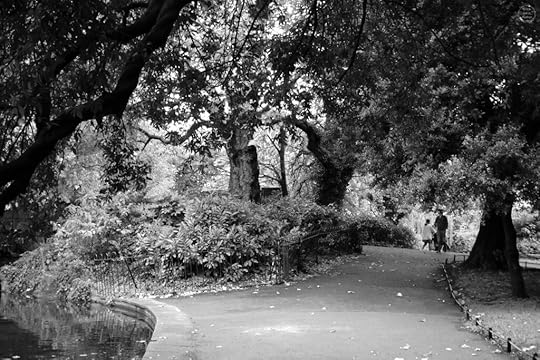
Many of the tropes of dark academia to my mind are really adaptable to that imaginary Poe-themed college:
Cool fall weather: this is a given to me, as the chill, mists and thick dark clouds just enhance the feeling of strangeness.Gothic architecture. Gargoyles are a natural for a darkened ambience, brooding from their rooftop perches over the people bustling along sidewalks below.I suppose the idea of snotty students studying the classics was designed to emphasize their inflated self-opinions. I studied a few such courses myself as part of what my university considered a way to round out my science major, and because they interested me – but to my mind, a great story would feature some really interesting character development through all kinds of different subjects. (And by the way, my studies in classical mythology led to some of the most memorable characters in my Chaos Roads trilogy.)The characters are usually brilliant and eccentric. Well, I don’t think brilliance necessarily equates with elitism – there are plenty of brilliant students from lower-income families. Brilliant villains are often the most interesting, though, because you wait to see what nastiness they’ve dreamed up, and how well they’re going to disguise it until the big reveal. And brilliant villains need an equal heroine/hero to battle them – Moriarty vs Sherlock Holmes.Expensive vices, such as smoking cigars or indulging in favourite tipples, might define some of the students and/or staff. There have been criticisms of the ‘glamourization’ of these kinds of behaviours. The truth is that students, let loose from home, often bust out and over-embrace their parentless freedom. In Donna Tartt’s novel The Secret History , the protagonist gets entangled with a group of students that he glamourizes in his own mind – wealthy-cool, part of a special study group, and encouraged by their prof to think beyond societal norms. In his place, I would have thought they were twits, but that wouldn’t have made a very good story, unless I somehow got dragged into their shenanigans against my will – which could have worked well instead. Writers choose certain permutations that work for the story they want to tell, and hopefully our readers enjoy them.Murder often stalks the halls of dark academia, because clearly something nefarious is going to happen. Within the dark fantasy or horror genres, the murders can be very creative indeed. Imagine an Agatha Christie scenario transposed to someplace supernatural – how fun would that be?! (Great idea for another book! )
)For my novels, I really enjoyed mapping out a college outside the Ontario government system, that was steeped in the uncanniness created by three converging ley lines and attracted students who might learn how to deal with other layers of reality. The entire campus was filled with eccentricities, and cozy pubs with great food to offset the deepest shadows.

After high school, I treasured my days at my perfectly ordinary university and learning all about science and mythology, but I would have really loved studying at Tempus College, where those two aspects not only met, but intertwined in strange and mysterious ways. Dark academia, if it’s done well, allows us our nostalgia while we step into an alternate, darker life for a while.
One of my favourite books, classified as a retelling of an old fairy tale, for me falls perfectly within the Dark Academia genre. In Tam Lin, by Pamela Dean, ancient powers stalk a 1970s campus, and the heroine must save her love from a darkly elite fellowship of students snared by a Fae. The university world is both typical and twisted, and the mystery deepens in a deliciously slow-cooked way. A great read as our days cool off, chill winds blow, early leaves swirl down and schools once again welcome learners through their doors, while I get busy mapping out the great idea I had above.
(All images are by me and may not be reproduced without my express permission. E. Jurus)
August 19, 2025
A victory in the freedom-to-read war
As an author, the news I’ve been watching most regularly from the U.S. is the coverage of book banning in schools and libraries. It may not seem to be the most important topic amid all the chaos around the world, but it’s a powerful symptom of the degradation of freedom, which often begins with trying to erase ideas.
The state of Florida, whose 2023 House Bill 1069 resulted in their schools removing hundreds of books for fear of prosecution, has been especially contentious. This week a lot of people in the literary world are celebrating a significant win.
Under Bill 1069, school librarians were to remove materials that contained “sexual conduct”, regardless of their literary or artistic merit, upon objection by some parents or residents of the county. Interestingly, there was a deadline – no more than 5 days after the objection – to remove the items for formal review, but none within which to hold the review. Nor did the bill require an item to be returned to shelves at any point after review. The Florida Department of Education training further wanted school librarians to “err on the side of caution”; if their libraries had materials with “sexual conduct,” they could be ‘punished’.
In August 2024, several individuals and organizations took a stand, filing a lawsuit against Florida public officials: two students and two parents; authors Julia Alvarez, Laurie Halse Anderson, John Green, Jodi Picoult, and Angie Thomas; the Authors Guild; and Penguin Random House along with five other publishers.
On August 14th this year, Judge Carlos Mendoza of the U.S. Middle District Court of Florida ruled in favour of the plaintiffs! In his 50-page judgement, he made some strong and interesting points:
That the Bill hadn’t supplied any specific parameters of what constituted “sexual conduct”, which then left the phrase open to interpretation based on the bias of the objector: “An ‘I know it when I see it’ test would unconstitutionally empower those who would limit speech to arbitrarily enforce the law. But the First Amendment empowers speakers instead.”That materials are to be judged by the Miller Test, the prevailing Supreme Court standard, which requires review of the materials as a whole, not just by a few passages or excerpts.As obscene material for minors is already prohibited under Florida law, there are not obscene materials for minors currently available in school and public libraries.State officials had argued that they were empowered to make decisions about the materials in school collections because they fell under “government speech” and so weren’t subject to the First Amendment. Judge Mendoza stated that “A blanket content-based prohibition on materials, rather than one based on individualized curation, hardly expresses any intentional government message at all. Slapping the label of government speech on book removals only serves to stifle the disfavored viewpoints.”
My books are available in our local public libraries. They would likely be subject to attempted banning in Florida and other states (for DEI content), which actually makes me proud. It’s frightening when people and governments try to erase ideas and cultures that they disagree with, and while Florida will probably appeal the ruling, it’s good to see momentum building on the side of freedom for all.
Banned Books Week is coming up in October. Thousands of people will be watching avidly to see how it goes this year.
August 12, 2025
125 Years of the Wizard of Emerald City
Every holiday season when I was a child, before the advent of video recorders, my family waited for The Wizard of Oz movie to come back on the air. The scarcity and annual tradition created even more enchantment than just the magic of the story itself.
That was my first introduction to L. Frank Baum’s wonderful story, although I did eventually borrow many of the sequels from the library.
This month is the 125th anniversary of the publication of The Wonderful Wizard of Oz, and what a legacy Baum’s imagination has left to the world. Most people know the adventures of Kansas farm girl Dorothy and her companions the Scarecrow, the Cowardly Lion and the Tin Man from the iconic Hollywood movie, but it all began in 1900 when Lyman Frank Baum put some ideas to paper.
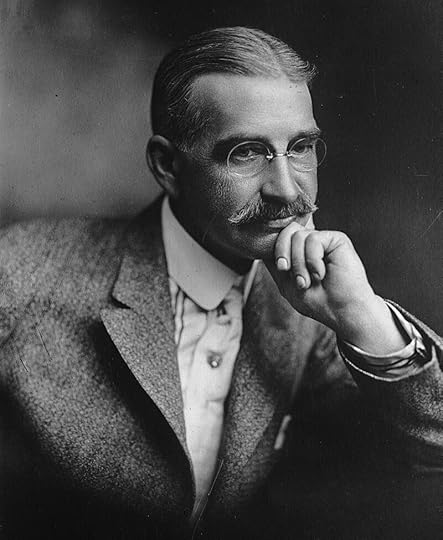 L. Frank Baum circa 1911
L. Frank Baum circa 1911By George Steckel – Los Angeles Times photographic archive, UCLA Library, Public Domain, https://commons.wikimedia.org/w/index.php?curid=18490343
Baum began writing as a child, and together with his brother Henry, published on their inexpensive printing press a journal named after their family estate, Rose Lawn, as well as pamphlets about stamp collecting. But Lyman had always been imaginative – he left Peekskill Military Academy after being disciplined for ‘daydreaming’.
As an adult he dabbled in raising chickens, stage hand, store clerk, and writing both plays and songs. Several years after marrying, he and his wife Maud moved to drought-ridden South Dakota, where he opened a shop briefly, and when that failed, began editing the local newspaper. Eventually he moved his family to Chicago to write and publish an assortment of books and sometimes work as a travelling salesman.
All of these experiences found his way into a story about a young farm girl whisked away by tornado to a magical, beautiful, colourful land.
 The title page of The Wonderful Wizard of Oz, also known as The Wizard of Oz, a 1900 children’s novel written by L. Frank Baum and illustrated by W. W. Denslow. By William Wallace Denslow – Electronic Text Center, University of Virginia Library, Public Domain, https://commons.wikimedia.org/w/index.php?curid=3470848
The title page of The Wonderful Wizard of Oz, also known as The Wizard of Oz, a 1900 children’s novel written by L. Frank Baum and illustrated by W. W. Denslow. By William Wallace Denslow – Electronic Text Center, University of Virginia Library, Public Domain, https://commons.wikimedia.org/w/index.php?curid=3470848A year before the publication of The Wonderful Wizard of Oz, he’d worked with illustrator W. W. Denslow on a collection of nonsense poetry, which became the best-selling children’s book of 1899. Following on the heels of that success, they partnered once again a year later, and it was Denslow’s charming illustrations that transformed the story and brought Baum’s characters to life.
Baum wrote, in the introduction, that the book “aspires to being a modernized fairy tale, in which the wonderment and joy are retained and the heart-aches and nightmares are left out”.
In his writer’s imagination, dried out South Dakota became dust-bowl Kansas. His niece, Dorothy, a sickly child who his wife had adored in place of the daughter she never had herself, died at the age of five months, and Baum kept her eternally alive as the heroine of his story.
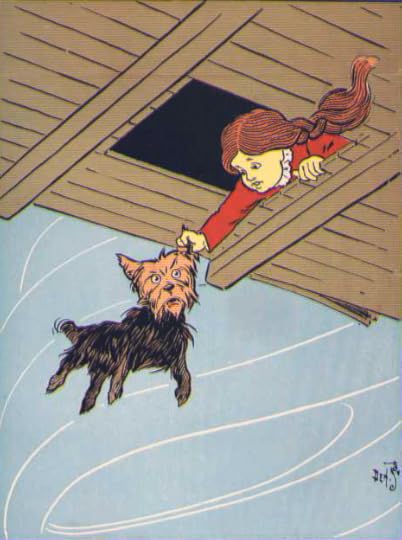 Dorothy catches Toto by the ear as their house is caught up in a cyclone (tornado). First edition illustration by W. W. Denslow. By William Wallace Denslow – Electronic Text Center, University of Virginia Library, Public Domain, https://commons.wikimedia.org/w/index.php?curid=3470879
Dorothy catches Toto by the ear as their house is caught up in a cyclone (tornado). First edition illustration by W. W. Denslow. By William Wallace Denslow – Electronic Text Center, University of Virginia Library, Public Domain, https://commons.wikimedia.org/w/index.php?curid=3470879His childhood nightmares of being chased by a scarecrow with ragged hay fingers transmuted in the friendly, scatterbrained Scarecrow that Dorothy rescues. Baum’s son said the inspiration for the Tin Woodman came from Baum’s fascination with window displays, and he tinkered with an assortment of scrap metals to build a man of tin.
The Cowardly Lion’s genesis has been much debated. Scholars feel that it represented the inner child struggling with fear and searching for courage, drawn perhaps from Baum’s own personality.
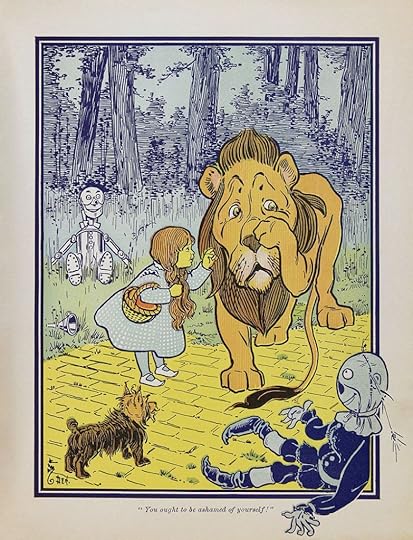 Dorothy meeting the Cowardly Lion (Denslow, 1900) By Illustration by W.W. Denslow (d. 1915) – Library of Congress LC Control No.: 03032405 (p. 81), Public Domain, https://commons.wikimedia.org/w/index.php?curid=4674617
Dorothy meeting the Cowardly Lion (Denslow, 1900) By Illustration by W.W. Denslow (d. 1915) – Library of Congress LC Control No.: 03032405 (p. 81), Public Domain, https://commons.wikimedia.org/w/index.php?curid=4674617The Land of Oz may have, for some reason, been inspired by Australia. In the books, Oz was an island continent somewhere to the west of California, with a great desert surrounded by habitation. In one of the sequels, Ozma of Oz (1907), Dorothy actually returned to Oz because of a great storm at sea while she and Uncle Henry were traveling by ship to Australia.
Chicago’s 1893 fair, when Jackson Square transformed into a luminous confection lit up by a million alabaster lights and filled arches, bridges, domes and pavilions, referred to by the newspapers as the “White City”, may have transformed in Baum’s mind into a magical place of emerald.
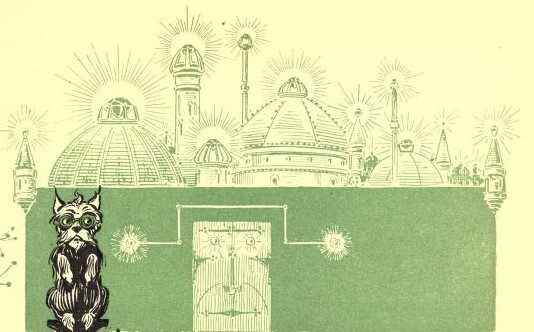 The Emerald City (Denslow, 1900)
The Emerald City (Denslow, 1900)By W. W. Denslow – https://archive.org/details/wonderfulwizardo00baumiala, Public Domain, https://commons.wikimedia.org/w/index.php?curid=69552113[image error]\"The Monkeys caught Dorothy in their arms and flew away with her.\"","created_timestamp":"0","copyright":"","focal_length":"0","iso":"0","shutter_speed":"0","title":"\"The Monkeys caught Dorothy in their arms and flew away with her.\"","orientation":"0"}" data-image-title="“The Monkeys caught Dorothy in their arms and flew away with her.”" data-image-description="" data-image-caption="
“The Monkeys caught Dorothy in their arms and flew away with her.”
" data-medium-file="https://i0.wp.com/ericajurus.ca/wp-co..." data-large-file="https://i0.wp.com/ericajurus.ca/wp-co..." src="https://i0.wp.com/ericajurus.ca/wp-co..." alt="" class="wp-image-3792" style="aspect-ratio:0.7314480308926408;width:470px;height:auto" srcset="https://i0.wp.com/ericajurus.ca/wp-co... 749w, https://i0.wp.com/ericajurus.ca/wp-co... 219w, https://i0.wp.com/ericajurus.ca/wp-co... 768w, https://i0.wp.com/ericajurus.ca/wp-co... 800w" sizes="auto, (max-width: 749px) 100vw, 749px" />The Winged Monkeys transport Dorothy. By William Wallace Denslow – https://www.wfae.org/post/following-yellow-brick-road-back-origins-oz#stream/0, Public Domain, https://commons.wikimedia.org/w/index.php?curid=3481830Something about L. Frank Baum’s dreams spoke to thousands of children, and to the child inside thousands of adults. The book was an enormous success, and when Hollywood enshrined it in film in 1939 with an incredible cast, the tale of Dorothy, her companions, the Wicked Witch of the West and her terrifying flying monkeys, and the hapless travelling showman masquerading as a wizard in a wonderful city of emerald, became an enduring part of our consciousness. If you haven’t watched it in a while, now’s the perfect time.
August 5, 2025
August mindset reboot
An abbreviated post, as I’m somewhat under the weather today. Feels like a bit of a bug, so I’m doing R&R. Precooked ham with an easy potato salad and green beans for dinner, and a nice cup of tea afterward.
August has always been a time of the year to gear up for the cooler weather approaching and the invigoration it brings, even if we’re no longer in school.
When I was in Toastmasters, the organization that helps people learn how to become accomplished public speakers, I served as the VP of Education for my club for several years, and each August I’d be planning out how I could help our members grow their skills after the summer hiatus. Members would often become complacent speakers within their own club, having gotten used to getting up in front of people they already knew well, and I loved to nudge them out of their comfort zone.
Because nothing changes if you keep doing the same old thing.
So maybe this is the time for you to work on that pet project you’ve had in mind, or try something new. Listen to the wise words of British novelist Doris Lessing, who won the Nobel Peace Prize in Literature. There’s never the ‘perfect’ time to take the leap – you just have to go for it! What adventures lie ahead if you do!



